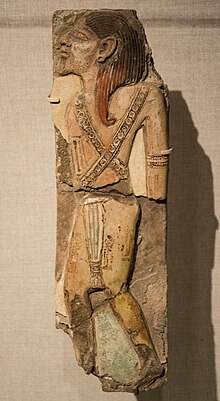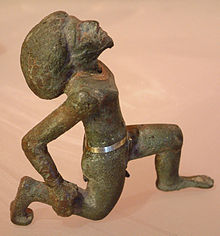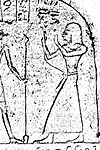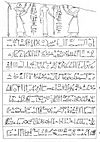Libu
| Libu in hieroglyphs | |||||||
|---|---|---|---|---|---|---|---|
rbw | |||||||

The Libu (
Ancient Egyptian: rbw; also transcribed Rebu, Lebu, Lbou, Libou) were an Ancient Libyan tribe of Berber origin, from which the name Libya derives.[1]
Early history


Their occupation of
Ramesside Period. The earliest occurrence is in a Ramesses II inscription.[2] There were no vowels in the Egyptian script. The name Libu is written as rbw in Egyptian hieroglyphs. In the Great Karnak Inscription Merneptah describes how hostilities between Egypt and Libya broke out in his regnal year 5 (1208 BCE) and how a coalition of Libu and Sea Peoples led by the chief of the Libu Meryey was defeated.[3][4] Libu appears as an ethnic name on the Merneptah Stele, also known as the Israel Stele.[5]
Ramesses III defeated the Libyans in the 5th year of his reign, but six years later the Libyans joined the Meshwesh and invaded the western Delta and were defeated again.[6]
This name Libu was taken over by the
Greeks of Cyrenaica, who co-existed with them.[7] Geographically, the name of this tribe was adopted by the Greeks for "Cyrenaica" as well as for northwestern Africa in general.[8]
In the neo-
masculine noun, and Lbt for the feminine noun of Libyan. The name supposedly was used as an ethnic name in those inscriptions.[9]
Great Chiefs of the Libu
In the Western
Sais, was more probably of Egyptian ethnicity rather than either Libu or Ma.[11] Later, Tefnakht claimed for himself even the pharaonic titles, founding the 24th Dynasty.[12]
Here follows the succession of the known "Great Chiefs of the Libu". They used to date their monuments following the regnal years of the contemporary pharaoh of the 22nd Dynasty.[13]
| Name | Image | Attested in regnal year... | Corresponding absolute datation | Notes |
|---|---|---|---|---|
| Inamunnifnebu |  |
Year 31 of Shoshenq III[13] | 795 BCE | - |
| Niumateped |  |
Year 4 of Shoshenq IV Year 8 of Shoshenq IV Year 10 of Shoshenq IV[14] |
- BCE | Possibly two different rulers with the same name |
| Tjerpahati |  |
Year 7 of Shoshenq V Year 15 of Shoshenq V[14] |
760 BCE 753 BCE |
Also known in literature as Tjerper or Titaru, son of Didi |
| Ker |  |
Year 19 of Shoshenq V[13] | 749 BCE | - |
| Rudamun | Year 30 of Shoshenq V[13] | 738 BCE | - | |
| Ankhhor | Year 37 of Shoshenq V Year ? of Shoshenq V[13] |
731 BCE ? BCE |
Struggled against Tefnakht and was likely defeated by him | |
| Tefnakht |  |
Year 36 of Shoshenq V Year 38 of Shoshenq V[13] |
732 BCE 730 BCE |
- |
See also
References
- .
- ISBN 0-521-22215-X
- ^ Breasted, James H. (1906) Ancient Records of Egypt, Part Three, Chicago, §§572ff.
- ISBN 9780974002507.
The seventy-nine line inscription is located on the interior of the east wall of the "Cours De la Cachette," directly north of a copy of the Hittite treaty from the reign of Ramesses II and in conjunction with other reliefs of Merneptah (PM II, p. 131 [486])... Unfortunately, the excavation of the Cours De la Cachette between 1978-1981 by the French expedition at Karnak did not discover any new blocks belonging to the Great Karnak Inscription of Merneptah, although it did demonstrate that the court was filled with many ritual and religious scenes in addition to its known military themes (F. LeSaout, "Reconstitution des murs de la Cours De la Cachette," Cahiers De Karrah VII (1978-1981) [Paris, 1982], p. 214).
- ISBN 0-19-500267-9
- ^ J. H. Breasted, Ancient Records of Egypt, Part Four, Chicago 1906, §§83ff. Afterward, the name appeared repeatedly in other pharaonic records.
- ISBN 0-521-21592-7
- ^ ."Libya". Online Etymology Dictionary. Retrieved 2016-11-24.
- ISBN 978-0830869541.
- ^ O'Connor, David. "Egyptians and Libyans in the New Kingdom" Expedition Magazine 29.3. Penn Museum, 1987
- ^ P.R. Del Francia, "Di una statuetta dedicata ad Amon-Ra dal grande capo dei Ma Tefnakht nel Museo Egizio di Firenze", S. Russo (ed.) Atti del V Convegno Nazionale di Egittologia e Papirologia, Firenze, 10-12 dicembre 1999, Firenze, 2000, p. 94
- ISBN 0-85668-298-5., § 249; 306
- ^ a b c d e f Berlandini, Jocelyne (1978). "Une stèle de donation du dynaste libyen Roudamon". BIFAO. 78: 162.
- ^ .
